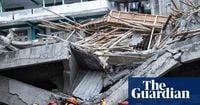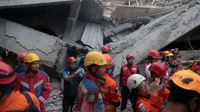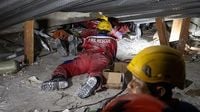Rescue workers in Sidoarjo, East Java, Indonesia, have been locked in a desperate race against time since Monday afternoon, after the sudden collapse of the century-old Al Khoziny Islamic boarding school left scores of students buried beneath heaps of concrete and twisted metal. The disaster struck at about 2:30 p.m. during afternoon prayers, catching hundreds of students—mostly boys between 12 and 18 years old—in the prayer hall as the building crumbled around them.
According to the Associated Press, the collapse was triggered by unauthorized construction work to add two new stories atop the existing two-storey structure. Authorities believe the old building’s foundations simply could not bear the additional weight, causing the entire structure to pancake and trap those inside. “The school’s management had not obtained permits for the expansion of the building,” the regent of Sidoarjo told BBC Indonesia, a fact that has since ignited scrutiny and calls for accountability.
By Wednesday, October 1, 2025, the National Disaster Management Agency (BNPB) reported that at least 91 students were still unaccounted for, a sharp increase from the initial estimate of 38 missing. The confusion, officials noted, was due to the chaos of the initial response and the challenge of reconciling attendance records with frantic family reports. “In the early stages there will inevitably be some confusion about the data,” Suharyanto, head of the National Disaster Mitigation Agency, explained to the Associated Press.
The official death toll stands at three, with nearly 100 injured, 26 of whom remain hospitalized. Most injuries involve head trauma and broken bones, reflecting the force of the collapse. Eleven people have been pulled from the wreckage since Monday, but two later succumbed to their injuries in hospital, according to rescue official Emi Freezer. The grim reality is that the longer survivors remain trapped, the slimmer their chances become. “We hope that we can complete this operation soon,” said Mohammad Syafii, head of Indonesia’s National Search and Rescue Agency Basarnas, at a news conference. “We are currently racing against time because it is possible that we can still save lives of those we have detected within the golden hours.”
Rescue teams—more than 300 strong, drawn from BNPB, the military, and national police—have been working around the clock, often in perilous conditions. The use of heavy equipment has been ruled out for now, as even a single vibration could destabilize the precarious piles of debris. Instead, rescuers are painstakingly digging by hand, creating tunnel-like passages and culverts to reach those trapped. Thermal drones, detectors, and a sophisticated search camera capable of detecting heartbeats have all been deployed, as reported by CNN and local news outlets.
At least six children have been confirmed alive beneath the rubble. Rescuers have managed to run oxygen, water, and food through narrow gaps—sometimes just 60 centimeters wide—hoping to sustain the trapped victims until they can be freed. “Rescue efforts are currently focused on manually digging holes and gaps to evacuate surviving victims,” BNPB said in a statement cited by The Jakarta Post. The situation remains precarious, with authorities warning that the slightest shift could trigger further collapse. “Shifting the slabs may also endanger the lives of survivors still trapped beneath the rubble,” Syafii told BBC Indonesia. “With the current construction, with this rubble, even a single vibration can cause other impacts.”
Rescue teams have been forced to adapt on the fly. One particularly harrowing case involves a survivor who is able to respond to rescuers but remains completely immobilized, prompting teams to construct a tunnel beneath the building in an attempt to reach him. Laksita Rini, head of the Fire and Rescue Department in Surabaya, told CNN that “once a specific location is identified, the chances of survival can be increased.”
For families, the wait has been excruciating. Relatives have camped outside the school, anxiously scanning lists of the missing and listening for any news. Scenes of loved ones calling out to the rubble, hoping for a response, have played out repeatedly. Holy Abdullah Arif, whose 13-year-old nephew was among the missing, recounted to Reuters: “I ran around screaming, ‘Rosi! Rosi! If you can hear me and can move, get out!’ And then a child was screaming back from the rubble, he was stuck. I thought that was Rosi, so I asked, ‘Are you Rosi?’ and the child said, ‘God, no, help me!’”
Survivors’ stories are harrowing. Thirteen-year-old Muhammad Rijalul Qoib described the moment the building began to crumble: “Many, perhaps hundreds of people, were about to pray. At that moment, I heard the sound of falling rocks. The sound continued, and it got louder and louder.” He managed to escape after being struck by falling debris, thanks to someone who pointed him toward an exit. Others, like Maulana Alvan Ibrahimavic—a student who had only enrolled four months ago—were not so fortunate. Police escorted his body to the funeral home on Monday night, according to local media reports.
The rescue effort has been further complicated by a 6.0 magnitude earthquake off Java island on Tuesday, which caused the rubble to shift and heightened the risk for those still trapped. “The rubble structure shifted and placed survivors at greater risk,” Basarnas head Syafii confirmed to CNN. Despite the dangers, special units equipped with breathing apparatus, medical evacuation gear, and extraction tools continue their painstaking work, hoping to reach survivors before the so-called “golden timeframe” of 72 hours elapses—a window after which survival rates drop dramatically.
Authorities have vowed to investigate the cause of the collapse. Early findings suggest that all four floors of the building stacked atop each other as the structure gave way, a result of the unauthorized and unsupervised construction. Indonesian Religious Affairs Minister Nasaruddin Umar, who visited the site, told Antara news agency, “This is a wake-up call. Many Islamic schools are built through community efforts without adequate technical supervision, which poses serious risks.”
As the rescue operation enters its third day, hope endures but is tempered by the realities of time and the dangers posed by the unstable wreckage. For the families gathered outside, every hour brings both dread and a glimmer of hope. For those still trapped, the efforts of hundreds of rescuers may yet offer a lifeline amid the ruins of a tragedy that has shaken a community—and a nation—to its core.


